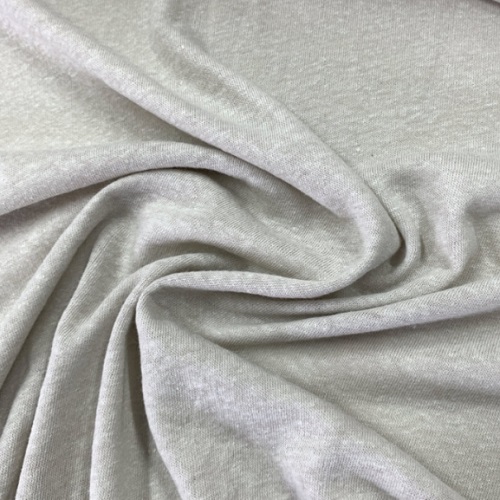0086-18057388688
Application and advantages of Linen Blend Jersey Fabric
Release Date : 2025.03.26
Viewd : 1
As consumers' demands for environmental protection, comfort and functionality increase, Linen Blend Jersey Fabric have become a popular choice in the textile field with their unique texture and performance.
1. Definition and characteristics of Linen Blend Jersey Fabric
1. Material composition and process
- Linen Blend Jersey Fabric are usually made of linen fibers (30%-70%) blended with cotton, polyester or viscose fibers.
- The plain knitting process is used to form a uniform, breathable and moderately elastic fabric structure.
2. Core characteristics
- Natural antibacterial property: Linen fibers have their own antibacterial function, reducing the growth of odor.
- Moisture absorption and breathability: The unique fiber structure can quickly absorb and evaporate sweat, making it suitable for summer wear.
- Soft and wrinkle-resistant: The blending process makes up for the wrinkle-prone shortcomings of pure linen and improves the drape of the fabric.
- Environmentally friendly and sustainable: Linen cultivation requires less pesticides, and blended materials can be recycled.
2. Four major application areas of linen blended jersey fabrics
1. Daily clothing
- T-shirts, dresses and other items are made of linen blended jersey fabrics, which are both comfortable and crisp.
- Suitable for making baby clothes because of its low allergenicity and skin-friendly properties.
2. Home textiles
- Bedding and sofa covers use the breathability of the fabric to create a refreshing home environment.
- Adding cotton fiber to the blending ratio can improve the softness of the touch.
3. Sports and outdoor clothing
- The moisture absorption and quick-drying properties of linen blended jersey fabrics are suitable for yoga clothes and hiking shirts.
- After adding elastic fibers (such as spandex), the ductility is enhanced and fits the body's movements.
4. Industrial and medical fields
- Make antibacterial gauze and protective clothing linings to give full play to the natural antibacterial advantages of linen.
- Industrial wipes can be used for cleaning precision instruments due to the high liquid absorption of the fabric.
3. Five advantages of choosing linen blended jersey fabrics
1. Four-season applicability
- Warm in winter and dissipate heat in summer, linen blended jersey fabrics can adapt to temperature changes.
2. Improved durability
- Blended fibers enhance the fabric's anti-pilling and abrasion resistance, extending its service life.
3. Design flexibility
- The jersey structure is easy to dye, which can present rich colors and printing effects.
4. Eco-friendly
- Compared with pure chemical fiber fabrics, the carbon footprint of linen blended jersey fabrics is reduced by more than 40%.
5. Cost balance
- The blending process reduces the high cost of pure linen while retaining its core advantages.
4. How to choose high-quality linen blended jersey fabrics?
1. Observe the fiber ratio
- A linen content below 50% may affect breathability, and it is recommended to choose a blending ratio of 50%-70%.
- Adding 5%-10% elastic fiber can improve freedom of movement.
2. Test fabric density
- High-count jersey fabrics are more delicate and suitable for high-end clothing.
- Use a magnifying glass to observe whether the texture is uniform to avoid loose structure that may cause deformation.
3. Test functionality
- Water dripping test: High-quality linen blended jersey fabrics should absorb and diffuse water quickly.
- Rub test: Fabrics that recover flatness after kneading are more wrinkle-resistant.
5. Care Guide for Linen Blended Jersey Fabrics
1. Washing Recommendations
- Hand wash or machine wash in cold water (gentle mode) to avoid shrinkage caused by high temperatures.
- Use neutral detergent to prevent alkaline ingredients from damaging linen fibers.
2. Drying and storage
- Lay flat to dry, avoid direct sunlight to prevent fading.
- Put the flax blended jersey fabric in a moisture-proof bag when folding and storing to prevent mildew.
3. Ironing tips
- Iron at medium temperature (below 150°C), and the steam mode can quickly eliminate wrinkles.
- Iron on the reverse side to protect the surface gloss of the fabric.
6. Future trends: technological innovation and market expansion
1. Intelligent blending technology
- Embed conductive fibers to enable flax blended jersey fabrics to have body temperature monitoring functions.
2. Fusion of bio-based materials
- Blended with corn fiber and seaweed fiber to create 100% biodegradable and environmentally friendly fabrics.
3. Functional coating upgrade
- Add waterproof nano coating to expand outdoor sports and industrial uses.
4. Customized production
- 3D knitting technology realizes personalized texture design to meet the needs of niche markets.
From daily wear to professional fields, flax blended jersey fabrics redefine the value of modern textiles with the combination of natural properties and technological empowerment. Whether it is a consumer who pursues a comfortable experience or a brand that focuses on sustainability, choosing this fabric means a common commitment to quality and responsibility. With the advancement of technology and the deepening of market demand, Linen Blend Jersey Fabric will surely lead a new round of green fashion revolution.

- Previous:No Information
- Next:No Information































